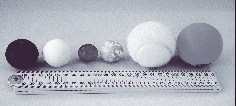|
Approach: Team
|
| Focus:
Plan, carry out and
report results for an experiment involving measuring the bounciness of balls.
Extrapolate results, check and interpret. |
 |
368k |
Resources: Tennis
ball (yellow), small rubber ball, rubber ball (mottled), soft foam ball (pink),
table tennis ball (white), squash ball (black), 1 metre folding ruler, activity
card, results sheet. |
|
Questions / instructions:
Get out 5 balls, keeping
the black ball separate.
Soon I will give you these five different balls.

Your
task is to work out a way to compare how bouncy the different balls are. You should
take some measurements for each ball, so that you can use numbers to say how bouncy
the balls are. Some of the balls bounce almost the same. You will have to measure
carefully to put them in the right order, from least bouncy to most bouncy. You
are to do your experiments on top of the table, in front of the camera. You are
to work as a team, and try to make sure that everyone helps.
|
Activity
card
|
| 1. Your task
is to find a way to compare how bouncy the different balls are. |
2. Think about
how you will do the experiment.
What will you keep the same?
What will you measure?
How will you use numbers to say how bouncy the balls are? |
| 3. You are
to work as a team, and try to make sure that everyone helps. |
| 4. Record your
measurements on the results sheet. |
First, you should plan how
you will do the experiment. Think about what things you will need to keep the
same. Think about what you will need to measure. Think about how you will use
numbers to say how bouncy each ball is. Sort out who is going to do the measurements
and who will do the other jobs. Everyone should have a job. Here is your main
tool.
Give the students the ruler.
Plan your experiment now, and tell me when you have finished your planning.
|
| a |
a |
a |
mean
score
|
|
y8
1999(1995)
|
| Planning
to achieve: |
a
|
| a |
consistent
height and release of balls
|
73 (73)
|
|
accurate
measurement of bounce
|
68
(73)
|
|
check
on consistency by replicating
|
5
(13)
|
|
requested
member participation
|
94
(77)
|
After
they have finished planning give the group the 5 balls — excluding the black
squash ball.
|
Results
sheet
|
| Yellow tennis
ball |
|
| White table
tennis ball |
|
| Small ball
|
|
| Soft pink ball
|
|
| Mottled ball
|
|
Here are the five balls,
and a sheet to record numbers for how bouncy each ball is. You can do your experiment
now. Tell me when you have finished and recorded all your results.
After they have finished
experimenting:
What did you find out in your experiment? Put the balls in order, from most bouncy
to least bouncy.
Are you sure that you
have the two least bouncy balls in the right order?
Show me by trying the balls again.
Record order of balls on their results sheet from 1 (most) to 5 (least).
a
|
a |
|
a
|
Experimentation: |
a
|
|
a
|
good
consistency in release of balls
|
56
(67)
|
|
good
accuracy in measurement
|
33
(37)
|
|
included
replication consistently
|
19
(20)
|
|
recorded
results accurately
|
52
(40)
|
| Reporting: |
a |
| a |
clear
and accurate
|
49
(46)
|
|
rather
"fuzzy"
|
42
(46)
|
|
very
unclear or inaccurate
|
9
(7)
|
Here
is another ball.
Give the students the black ball. How high do you think this one will bounce?
Make a prediction and tell me why you think that. |
a |
| a |
Predictions
and discussions: |
a
|
| a |
very
good
|
33
(37)
|
|
moderate
|
56
(52)
|
|
poor
|
11
(11)
|
After
discussion:
Test the ball and see if you were right. |
a |
Commentary:
Apart from replication, most teams of students included important issues in their
planning for the experiment. Only 20 percent checked their measurements by replication.
Measurements and recording were also not done particularly well. Overall, the
results for 1995 and 1999 are very similar, despite some fluctuations on individual
factors. |